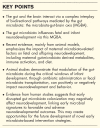Microbiome and its impact on fetal and neonatal brain development: current opinion in pediatrics
- PMID: 38488112
- PMCID: PMC10990016
- DOI: 10.1097/MCO.0000000000001028
Microbiome and its impact on fetal and neonatal brain development: current opinion in pediatrics
Abstract
Purpose of review: Emerging evidence suggests that the gut microbiota and its metabolites regulate neurodevelopment and cognitive functioning via a bi-directional communication system known as the microbiota-gut-brain axis (MGBA).
Recent findings: The MGBA influences brain development and function via the hypothalamic-pituitary axis, the vagal nerve, immune signaling, bacterial production of neurotransmitters, and microbial metabolites like short-chain fatty acids, tryptophan derivatives, and bile acids. Animal studies show fetal neurodevelopment is mediated by maternal microbiota derivatives, immune activation, and diet. Furthermore, manipulation of the microbiota during critical windows of development, like antibiotic exposure and fecal microbiota transplantation, can affect cognitive functioning and behavior in mice. Evidence from human studies, particularly in preterm infants, also suggests that a disrupted gut microbiota colonization may negatively affect neurodevelopment. Early microbial signatures were linked to favorable and adverse neurodevelopmental outcomes.
Summary: The link between the gut microbiota and the brain is evident. Future studies, including experimental studies, larger participant cohort studies with longitudinal analyses of microbes, their metabolites, and neurotransmitters, and randomized controlled trials are warranted to further elucidate the mechanisms of the MGBA. Identification of early, predictive microbial markers could pave the way for the development of novel early microbiota-based intervention strategies, such as targeted probiotics, and vaginal or fecal microbiota transplantation, aimed at improving infant neurodevelopment.
Copyright © 2024 The Author(s). Published by Wolters Kluwer Health, Inc.
Conflict of interest statement
Figures


References
Publication types
MeSH terms
Substances
LinkOut - more resources
Full Text Sources
Medical
Research Materials

